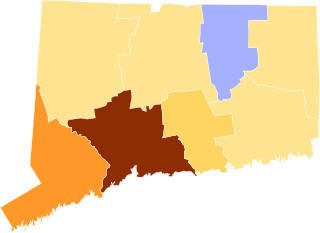
Henry Dutton was an American politician and the 38th Governor of Connecticut.

The 1854 New York state election was held on November 7, 1854, to elect the governor, the lieutenant governor, a Canal Commissioner and an Inspector of State Prisons, as well as all members of the New York State Assembly.
The following table indicates the party of elected officials in the U.S. state of Connecticut:

The 1854–55 United States Senate elections were held on various dates in various states. As these U.S. Senate elections were prior to the ratification of the Seventeenth Amendment in 1913, senators were chosen by state legislatures. Senators were elected over a wide range of time throughout 1854 and 1855, and a seat may have been filled months late or remained vacant due to legislative deadlock. In these elections, terms were up for the senators in Class 3.

The 1857 Connecticut gubernatorial election was held on April 6, 1857. Former Lieutenant Governor and Republican nominee Alexander H. Holley defeated former congressman and Democratic nominee Samuel Ingham with 50.44% of the vote.

The 1856 Connecticut gubernatorial election was held on April 7, 1856. Incumbent governor and American Party nominee William T. Minor defeated former congressman and Democratic nominee Samuel Ingham and former Comptroller of Connecticut and Republican nominee Gideon Welles with 38.99% of the vote.

The 1854 Connecticut gubernatorial election was held on April 3, 1854. Former state legislator and Whig Party nominee Henry Dutton defeated former congressman and Democratic nominee Samuel Ingham and former congressman Charles Chapman with 31.89% of the vote.

The 1853 Connecticut gubernatorial election was held on April 4, 1853. Incumbent governor and Democratic Party nominee Thomas H. Seymour defeated former state legislator and Whig nominee Henry Dutton and former state legislator and Free Soil nominee Francis Gillette with 51.01% of the vote.

The 1852 Connecticut gubernatorial election was held on April 5, 1852. Incumbent governor and Democratic Party nominee Thomas H. Seymour defeated incumbent Lieutenant Governor and Whig nominee Green Kendrick with 50.39% of the vote.

The 1851 Connecticut gubernatorial election was held on April 7, 1851. It was a rematch of the 1850 Connecticut gubernatorial election. Incumbent governor and Democratic Party nominee Thomas H. Seymour defeated former state legislator and Whig nominee Lafayette S. Foster with 48.94% of the vote.

The 1850 Connecticut gubernatorial election was held on April 1, 1850. Former congressman and Democratic Party nominee Thomas H. Seymour defeated former state legislator and Whig nominee Lafayette S. Foster with 48.11% of the vote.

The 1848 Connecticut gubernatorial election was held on April 3, 1848. Incumbent Governor and Whig nominee Clark Bissell was re-elected, defeating former congressman and Democratic nominee George S. Catlin with 50.38% of the vote.

The 1845 Connecticut gubernatorial election was held on April 7, 1845. Incumbent governor, Amistad lawyer and Whig nominee Roger Sherman Baldwin was re-elected, defeating former congressman and Democratic nominee Isaac Toucey with 51.00% of the vote.

The 1844 Connecticut gubernatorial election was held on April 1, 1844. Former state legislator, Amistad lawyer and Whig nominee Roger Sherman Baldwin was elected, defeating incumbent governor and Democratic nominee Chauncey Fitch Cleveland with 49.41% of the vote.

The 1842 Connecticut gubernatorial election was held on April 4, 1842. Former Speaker of the Connecticut House of Representatives and Democratic nominee Chauncey Fitch Cleveland was elected, defeating incumbent governor and Whig nominee William W. Ellsworth with 49.94% of the vote.

The 1835 Connecticut gubernatorial election was held on April 6, 1835. It was a rematch of the 1834 Connecticut gubernatorial election. Former governor, senator and Democratic nominee Henry W. Edwards was elected, defeating incumbent governor and Whig nominee Samuel A. Foot with 52.13% of the vote.

The 1834 Connecticut gubernatorial election was held on April 7, 1834. Former senator and Whig nominee Samuel A. Foot was elected, defeating incumbent governor and Democratic nominee Henry W. Edwards with 49.83% of the vote.

The 1833 Connecticut gubernatorial election was held on April 1, 1833. Former senator and Democratic nominee Henry W. Edwards was elected, defeating incumbent governor and National Republican nominee John S. Peters with 41.31% of the vote.

The 1849 Rhode Island gubernatorial election was held on April 4, 1849.

The 1845–46 Massachusetts gubernatorial election consisted of an initial popular election held on November 10, 1845 that was followed by a legislative vote held on January 12, 1846. The ultimate task of electing the governor had been placed before the Massachusetts General Court because no candidate received the majority of the vote required for a candidate to be elected through the popular election. Incumbent Whig Governor George N. Briggs defeated Democratic nominee Isaac Davis, Liberty Party nominee Samuel E. Sewall and Know Nothing nominee Henry Shaw.
























